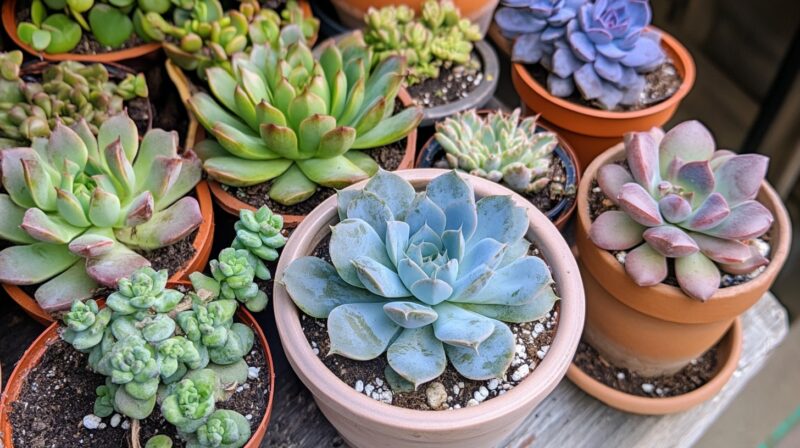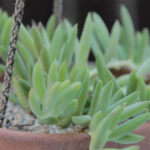Succulents have become a favorite for many plant lovers because of their unique look and ability to thrive with minimal care.
However, while they are known for being low-maintenance, they still need the right amount of sunlight to grow properly.
Giving your succulents too much or too little light can cause problems, such as stretching, discoloration, or even burning.
Let us talk about it in greater detail.
General Sunlight Needs for Succulents
Most succulents thrive when they receive about six hours of sunlight per day, but there are important factors to consider for healthy growth and preventing damage.
- Four to six hours of sunlight daily: This helps succulents maintain their bright colors and compact shapes.
- Gradual exposure: When moving succulents from low light to full sun, introduce them to the light gradually to avoid shock.
- Avoid sudden changes: A quick shift to intense sunlight can cause sunburn or scorch the leaves, especially in species not used to direct sunlight.
- Direct vs. filtered sunlight: While many succulents prefer direct sun, delicate varieties benefit from filtered light.
- Creating filtered sunlight: Position succulents behind a curtain or in a spot where they get bright, indirect light for a gentler exposure.
Furthermore, a lot will depend on whether they are inside or outside the home.
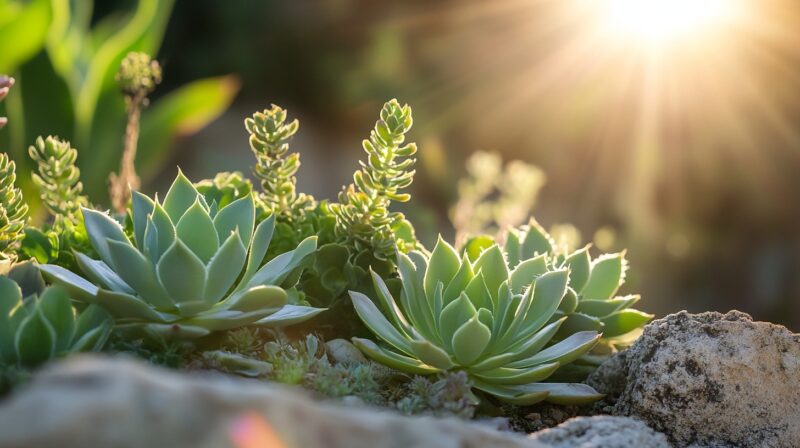
Outdoor
For succulents grown outdoors, the environment plays a major role in their sunlight needs. In temperate climates like California’s coastal areas, succulents generally thrive in full sun with occasional shade.
The coastal mist and maritime layers also help reduce watering needs, making it an ideal setting for these plants.
Morning sun or bright shade tends to be the best choice, as it provides enough light without overwhelming the plants during the hottest part of the day.
In desert climates such as Arizona or Nevada, the intense summer sun can actually damage succulents. In these regions, succulents do better in bright shade or areas that are protected from the intense afternoon sun.
Varieties like Aloe Vera, Euphorbia, and Ponytail Palms are more tolerant of stronger sunlight, but they still require some protection during peak heat.
For succulents in these environments, shade cloths or placing them under trees can help protect them from sunburn while ensuring they get the light they need.
Indoor
Indoor succulents have different sunlight requirements compared to their outdoor counterparts. The best placement for indoor succulents is near a south or west-facing window, as these locations receive the most sunlight throughout the day.
However, it’s important to avoid placing succulents directly on the window glass, as the heat magnified through the glass can burn the plants. Keeping them a few inches away from the window is often enough to avoid this issue.
Since succulents tend to grow toward the light, rotating them every few days ensures even light exposure and prevents them from becoming lopsided. In low-light environments, artificial lighting or grow lights can be used to supplement natural light.
Succulents require light for photosynthesis, and without enough, they can become leggy and weak.
By placing them under grow lights for a few hours a day, you can ensure your succulents remain healthy even if natural light is limited.
Signs of Too Much or Too Little Sun
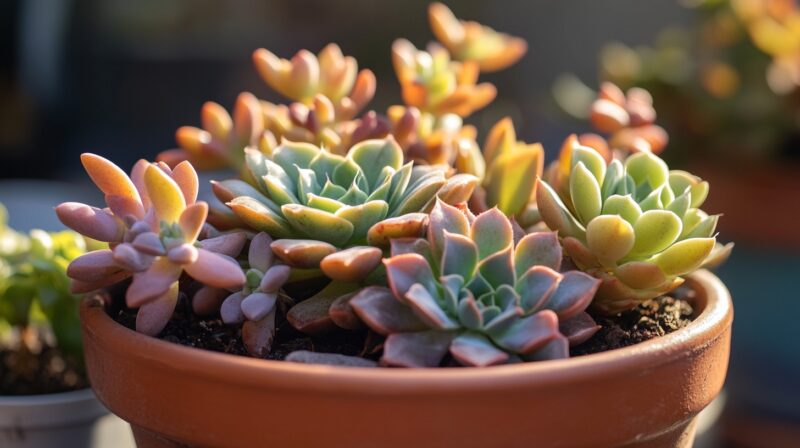
Succulents are highly adaptive plants, but they are also sensitive to the amount of sunlight they receive. Understanding the signs of both excessive and insufficient sunlight is crucial for keeping your succulents healthy.
These signs can help you adjust their environment to ensure they receive the optimal light needed for growth and vitality.
Too Much Sun
Succulents, although sun-loving plants, can suffer from too much sunlight, especially during the hottest parts of the day. Prolonged direct exposure can lead to sunburn, which affects both the plant’s appearance and health.
It is especially common when plants are not properly acclimated to stronger light conditions after being grown in shade or indoors.
Recognizing the signs of excessive sun exposure early can help prevent lasting damage.
- Discoloration: Leaves lose their vibrant green hue, appearing faded or washed out.
- Scorching: Brown, black, or dark red patches develop, particularly around the edges and tips of the leaves.
- Dry and crispy leaves: Affected areas may feel brittle and dry to the touch.
- Shriveling: Severe sun damage can cause the leaves to thin and shrivel due to dehydration.
If you observe these signs, move your succulents to a shadier location that offers indirect light or filtered sunlight. You can also protect them by using shade cloths, sheer curtains, or positioning them under larger plants.
While minimal sunburn may allow for recovery, severely damaged leaves often won’t heal and may need to be trimmed to encourage healthy growth.

Too Little Sun
Succulents are adapted to thrive in bright conditions, and when they don’t receive enough sunlight, they start to display clear signs of distress.
One of the most common issues caused by insufficient sunlight is etiolation, where the plant stretches in search of more light.
It affects both the appearance and health of the plant, leaving it weak and more vulnerable to environmental stressors.
Recognizing the signs of too little sun is essential to restore balance and ensure your succulent continues to grow strong and healthy.
- Leggy or stretched-out growth: Succulents will grow long, thin stems with leaves spaced far apart as they “reach” for a light source.
- Unbalanced, top-heavy appearance: The plant may become top-heavy, with disproportionately long stems and small leaves, causing it to lean or fall over.
- Pale or faded color: The vibrant color of the succulent may fade, and in some cases, the leaves can turn a lighter shade of green, yellow, or even white.
- Smaller leaves: The leaves may shrink in size as the plant focuses energy on stretching toward the light rather than maintaining its full structure.
- Fragile growth: The plant becomes weaker and less resilient to changes in its environment, making it more prone to dehydration or damage.
Addressing these signs quickly by moving the succulent to a brighter location or introducing artificial lighting will help prevent further damage and promote healthy, compact growth.
Sunlight Needs for Baby Succulents and Succulent Cuttings
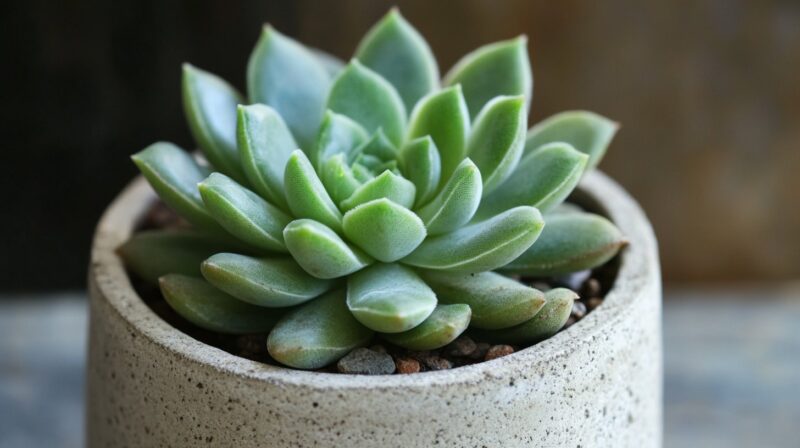
Baby succulents and succulent cuttings, while requiring as much sunlight as mature plants, are more sensitive to direct, intense sunlight.
Exposing them to too much sun can cause their delicate leaves to scorch. It’s best to provide these young plants with indirect sunlight or bright, filtered light until they develop stronger roots and can tolerate harsher conditions.
For cuttings, the process is similar. New cuttings should be kept in a bright location but out of direct sunlight until they have rooted.
Once they’ve established themselves, they can gradually be introduced to more sunlight, similar to the process with mature succulents. Patience is key when it comes to acclimating young plants to brighter conditions.
- Also Read: My friend tried to grow a string of bananas plant outdoors, and she made it! Learn more about how she did it here.
The Bottom Line
Succulents’ sunlight needs to vary based on their environment, with outdoor plants requiring different care than indoor ones.
By paying close attention to the signs your succulent gives and adjusting sunlight exposure as necessary, you can keep your plants healthy and vibrant.
Don’t hesitate to experiment and observe what works best for your succulents to ensure they thrive.

